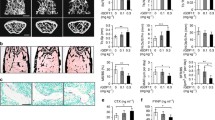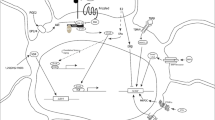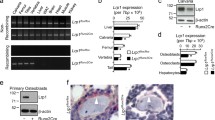Abstract
Human genetic studies have firmly established a link between bone mass in humans and gain-of-function or loss-of-function mutations in a Wnt coreceptor, low-density lipoprotein receptor-related protein 5 (LRP5), or in the Wnt antagonist sclerostin, and several molecular genetic studies in mice have consistently confirmed the critical importance of the Wnt signaling pathway in skeletal biology and disease. In what may be a novel paradigm, the ubiquitous nature of LRP5/6 and Wnt signaling is counterbalanced by the bone-restricted and regulated expression of Wnt antagonists such as sclerostin and Dickkopf-1 (Dkk1) in adult tissues, offering new and potentially safe therapeutic means of intervention to stimulate bone formation.
Similar content being viewed by others
References and Recommended Reading
Aubin JE, Triffit JT: Mesenchymal stem cells and osteoblast differentiation. In Principles of Bone Biology. Edited by Bilezikian JP, Raisz LG, Rodan GA. San Diego, CA: Academic Press; 2002:59–82.
Khosla S: Minireview: the OPG/RANKL/RANK system. Endocrinology 2001, 142:5050–5055.
Suda T, Takahashi N, Udagawa N, et al.: Modulation of osteoclast differentiation and function by the new members of the tumor necrosis factor receptor and ligand families. Endocr Rev 1999, 20:345–357.
Simonet WS, Lacey DL, Dunstan CR, et al.: Osteoprotegerin: a novel secreted protein involved in the regulation of bone density. Cell 1997, 89:309–319.
Deaton DN, Tavares FX: Design of cathepsin K inhibitors for osteoporosis. Curr Top Med Chem 2005, 5:1639–1675.
Zaidi M, Troen B, Moonga BS, Abe E: Cathepsin K, osteoclastic resorption, and osteoporosis therapy. J Bone Miner Res 2001, 16:1747–1749.
Zhao C, Irie N, Takada Y, et al.: Bidirectional ephrinB2-EphB4 signaling controls bone homeostasis. Cell Metab 2006, 4:111–121.
Boyden LM, Mao J, Belsky J, et al.: High bone density due to a mutation in LDL-receptor-related protein 5. N Engl J Med 2002, 346:1513–1521.
Gong Y, Slee RB, Fukai N, et al.: LDL receptor-related protein 5 (LRP5) affects bone accrual and eye development. Cell 2001, 107:513–523.
Little RD, Carulli JP, Del Mastro RG, et al.: A mutation in the LDL receptor-related protein 5 gene results in the autosomal dominant high-bone-mass trait. Am J Hum Genet 2002, 70:11–19.
Staehling-Hampton K, Proll S, Paeper BW, et al.: A 52-kb deletion in the SOST-MEOX1 intergenic region on 17q12–q21 is associated with van Buchem disease in the Dutch population. Am J Med Genet 2002, 110:144–152.
Balemans W, Patel N, Ebeling M, et al.: Identification of a 52 kb deletion downstream of the SOST gene in patients with van Buchem disease. J Med Genet 2002, 39:91–97.
Clevers H: Wnt/beta-catenin signaling in development and disease [review]. Cell 2006, 127:469–480.
Wehrli M, Dougan ST, Caldwell K, et al.: Arrow encodes an LDL-receptor-related protein essential for Wingless signalling. Nature 2000, 407:527–530.
Jeon H, Meng W, Takagi J, et al.: Implications for familial hypercholesterolemia from the structure of the LDL receptor YWTD-EGF domain pair. Nat Struct Biol 2001, 8:499–504.
Zeng X, Tamai K, Doble B, et al.: A dual-kinase mechanism for Wnt co-receptor phosphorylation and activation. Nature 2005, 438:873–877.
Davidson G, Wu W, Shen J, et al.: Casein kinase 1 gamma couples Wnt receptor activation to cytoplasmic signal transduction. Nature 2005, 438:867–872.
Hay E, Faucheu C, Suc-Royer I, et al.: Interaction between LRP5 and Frat1 mediates the activation of the Wnt canonical pathway. J Biol Chem 2005, 280:13616–13623.
Chen HJ, Lin CM, Lin CS, et al.: The role of microtubule actin cross-linking factor 1 (MACF1) in the Wnt signaling pathway. Genes Dev 2006, 20:1933–1945.
Mani A, Radhakrishnan J, Wang H, et al.: LRP6 mutation in a family with early coronary disease and metabolic risk factors. Science 2007, 315:1278–1282.
Kato M, Patel MS, Levasseur R, et al.: Cbfa1-independent decrease in osteoblast proliferation, osteopenia, and persistent embryonic eye vascularization in mice deficient in Lrp5, a Wnt coreceptor. J Cell Biol 2002, 157:303–314.
Van Wesenbeeck L, Cleiren E, Gram J, et al.: Six novel missense mutations in the LDL receptor-related protein 5 (LRP5) gene in different conditions with an increased bone density. Am J Hum Genet 2003, 72:763–771.
Kiel DP, Ferrari SL, Cupples LA, et al.: Genetic variation at the low-density lipoprotein receptor-related protein 5 (LRP5) locus modulates Wnt signaling and the relationship of physical activity with bone mineral density in men. Bone 2007, 40:587–596.
Koller DL, Ichikawa S, Johnson ML, et al.: Contribution of the LRP5 gene to normal variation in peak BMD in women. J Bone Miner Res 2005, 20:75–80.
Ferrari SL, Deutsch S, Antonarakis SE: Pathogenic mutations and polymorphisms in the lipoprotein receptor-related protein 5 reveal a new biological pathway for the control of bone mass. Curr Opin Lipidol 2005, 16:207–214.
Hartikka H, Makitie O, Mannikko M, et al.: Heterozygous mutations in the LDL receptor-related protein 5 (LRP5) gene are associated with primary osteoporosis in children. J Bone Miner Res 2005, 20:783–789.
Urano T, Shiraki M, Ezura Y, et al.: Association of a single-nucleotide polymorphism in low-density lipoprotein receptor-related protein 5 gene with bone mineral density. J Bone Miner Metab 2004, 22:341–345.
Clement-Lacroix P, Ai M, Morvan F, et al.: Lrp5-independent activation of Wnt signaling by lithium chloride increases bone formation and bone mass in mice. Proc Natl Acad Sci U S A 2005, 102:17406–17411.
Babij P, Zhao W, Small C, et al.: High bone mass in mice expressing a mutant LRP5 gene. J Bone Miner Res 2003, 18:960–974.
Bennett CN, Longo KA, Wright WS, et al.: Regulation of osteoblastogenesis and bone mass by Wnt10b. Proc Natl Acad Sci U S A 2005, 102:3324–3329.
Bodine PV, Zhao W, Kharode YP, et al.: The Wnt antagonist secreted frizzled-related protein-1 is a negative regulator of trabecular bone formation in adult mice. Mol Endocrinol 2004, 18:1222–1237.
Glass DA 2nd, Bialek P, Ahn JD, et al.: Canonical Wnt signaling in differentiated osteoblasts controls osteoclast differentiation. Dev Cell 2005, 8:751–764.
Holmen SL, Zylstra CR, Mukherjee A, et al.: Essential role of beta-catenin in postnatal bone acquisition. J Biol Chem 2005, 280:21162–21168.
Morvan F, Boulukos K, Clement-Lacroix P, et al.: Deletion of a single allele of the Dkk1 gene leads to an increase in bone formation and bone mass. J Bone Miner Res 2006, 21:934–945.
Li J, Sarosi I, Cattley RC, et al.: Dkk1-mediated inhibition of Wnt signaling in bone results in osteopenia. Bone 2006, 39:754–766.
Nakanishi T, Yamaai T, Asano M, et al.: Overexpression of connective tissue growth factor/hypertrophic chondrocyte-specific gene product 24 decreases bone density in adult mice and induces dwarfism. Biochem Biophys Res Commun 2001, 281:678–681.
Cao J, Morony S, Warmington K, et al.: Transgenic overexpression of WIF-1, a secreted Wnt antagonist expressed in bone, causes decreased bone mineral density and increased susceptibility to bone fracture in mice: a role for WIF-1 in bone biology. J Bone Miner Res 2004, 19:S55.
Hill TP, Taketo MM, Birchmeier W, Hartmann C: Multiple roles of mesenchymal beta-catenin during murine limb patterning. Development 2006, 133:1219–1229.
Hill TP, Spater D, Taketo MM, et al.: Canonical Wnt/betacatenin signaling prevents osteoblasts from differentiating into chondrocytes. Dev Cell 2005, 8:727–738.
Day TF, Guo X, Garrett-Beal L, Yang Y: Wnt/beta-catenin signaling in mesenchymal progenitors controls osteoblast and chondrocyte differentiation during vertebrate skeletogenesis. Dev Cell 2005, 8:739–750.
Rawadi G, Vayssiere B, Dunn F, et al.: BMP-2 controls alkaline phosphatase expression and osteoblast mineralization by a Wnt autocrine loop. J Bone Miner Res 2003, 18:1842–1853.
Kalajzic I, Staal A, Yang WP, et al.: Expression profile of osteoblast lineage at defined stages of differentiation. J Biol Chem 2005, 280:24618–24626.
Roman-Roman S, Garcia T, Jackson A, et al.: Identification of genes regulated during osteoblastic differentiation by genome-wide expression analysis of mouse calvaria primary osteoblasts in vitro. Bone 2003, 32:474–482.
Vaes BL, Dechering KJ, van Someren EP, et al.: Microarray analysis reveals expression regulation of Wnt antagonists in differentiating osteoblasts. Bone 2005, 36:803–811.
Li X, Liu P, Liu W, et al.: Dkk2 has a role in terminal osteoblast differentiation and mineralized matrix formation. Nat Genet 2005, 37:945–952.
Diarra D, Stolina M, Polzer K, et al.: Dickkopf-1 is a master regulator of joint remodeling. Nat Med 2007, 13:156–163.
Tian E, Zhan F, Walker R, et al.: The role of the Wnt-signaling antagonist DKK1 in the development of osteolytic lesions in multiple myeloma. N Engl J Med 2003, 349:2483–2494.
Harwood AJ: Regulation of GSK-3: a cellular multiprocessor. Cell 2001, 105:821–824.
Vestergaard P, Rejnmark L, Mosekilde L: Reduced relative risk of fractures among users of lithium. Calcif Tissue Int 2005, 77:1–8.
Kulkarni NH, Onyia JE, Zeng Q, et al.: Orally bioavailable GSK-3alpha/beta dual inhibitor increases markers of cellular differentiation in vitro and bone mass in vivo. J Bone Miner Res 2006, 21:910–920.
Poole KE, van Bezooijen RL, Loveridge N, et al.: Sclerostin is a delayed secreted product of osteocytes that inhibits bone formation. FASEB J 2005, 19:1842–1844.
Ellies DL, Viviano B, McCarthy J, et al.: Bone density ligand, Sclerostin, directly interacts with LRP5 but not LRP5G171V to modulate Wnt activity. J Bone Miner Res 2006, 21:1738–1749.
Semenov M, Tamai K, He X: SOST is a ligand for LRP5/ LRP6 and a Wnt signaling inhibitor. J Biol Chem 2005, 280:26770–26775.
Semenov MV, He X: LRP5 mutations linked to high bone mass diseases cause reduced LRP5 binding and inhibition by SOST. J Biol Chem 2006, 281:38276–38284.
Brunkow ME, Gardner JC, Van Ness J, et al.: Bone dysplasia sclerosteosis results from loss of the SOST gene product, a novel cystine knot-containing protein. Am J Hum Genet 2001, 68:577–589.
Balemans W, Ebeling M, Patel N, et al.: Increased bone density in sclerosteosis is due to the deficiency of a novel secreted protein (SOST). Hum Mol Genet 2001, 10:537–543.
Bellido T, Ali AA, Gubrij I, et al.: Chronic elevation of parathyroid hormone in mice reduces expression of sclerostin by osteocytes: a novel mechanism for hormonal control of osteoblastogenesis. Endocrinology 2005, 146:4577–4583.
Keller H, Kneissel M: SOST is a target gene for PTH in bone. Bone 2005, 37:148–158.
Robling AG, Bellido T, Turner CH: Mechanical stimulation in vivo reduces osteocyte expression of sclerostin. J Musculoskelet Neuronal Interact 2006, 6:354.
Ominsky M, Warmington KS, Asuncion FJ, et al.: Sclerostin monoclonal antibody treatment increases bone strength in aged osteopenic ovariectomized rats [abstract]. J Bone Min Res 2006, 21:S44 (Abstract 1161).
Ominsky M, Stouch B, Doellgast G, et al.: Administration of sclerostin monoclonal antibodies to female Cynomologous monkeys results in increased bone formation, bone mineral density and bone strength [abstract]. J Bone Min Res 2006, 21:S44 (Abstract 1162).
Holmen SL, Robertson SA, Zylstra CR, Williams BO: Wnt-independent activation of beta-catenin mediated by a Dkk1-Fz5 fusion protein. Biochem Biophys Res Commun 2005, 328:533–539.
Bafico A, Liu G, Yaniv A, et al.: Novel mechanism of Wnt signalling inhibition mediated by Dickkopf-1 interaction with LRP6/Arrow. Nat Cell Biol 2001, 3:683–686.
Brott BK, Sokol SY: Regulation of Wnt/LRP signaling by distinct domains of Dickkopf proteins. Mol Cell Biol 2002, 22:6100–6110.
Mao B, Wu W, Li Y, et al.: LDL-receptor-related protein 6 is a receptor for Dickkopf proteins. Nature 2001, 411:321–325.
Semenov MV, Tamai K, Brott BK, et al.: Head inducer Dickkopf-1 is a ligand for Wnt coreceptor LRP6. Curr Biol 2001, 11:951–961.
Li L, Mao J, Sun L, et al.: Second cysteine-rich domain of Dickkopf-2 activates canonical Wnt signaling pathway via LRP-6 independently of dishevelled. J Biol Chem 2002, 277:5977–5981.
Davidson G, Mao B, del Barco Barrantes I, Niehrs C: Kremen proteins interact with Dickkopf1 to regulate anteroposterior CNS patterning. Development 2002, 129:5587–5596.
Mao B, Wu W, Davidson G, et al.: Kremen proteins are Dickkopf receptors that regulate Wnt/beta-catenin signalling. Nature 2002, 417:664–667.
Mao B, Niehrs C: Kremen2 modulates Dickkopf2 activity during Wnt/LRP6 signaling. Gene 2003, 302:179–183.
Wang FS, Ko JY, Lin CL, et al.: Knocking down dickkopf-1 alleviates estrogen deficiency induction of bone loss. A histomorphological study in ovariectomized rats. Bone 2007, 40:485–492.
Guise TA, Mohammad KS, Clines G, et al.: Basic mechanisms responsible for osteolytic and osteoblastic bone metastases. Clin Cancer Res 2006, 12:6213s–6216s.
Hall CL, Bafico A, Dai J, et al.: Prostate cancer cells promote osteoblastic bone metastases through Wnts. Cancer Res 2005, 65:7554–7560.
Yaccoby S, Ling W, Zhan F, et al.: Antibody-based inhibition of DKK1 suppresses tumor-induced bone resorption and multiple myeloma growth in vivo. Blood 2007, 109:2106–2111.
Pacifici M, Koyama E, Shibukawa Y, et al.: Cellular and molecular mechanisms of synovial joint and articular cartilage formation. Ann N Y Acad Sci 2006, 1068:74–86.
Author information
Authors and Affiliations
Corresponding author
Rights and permissions
About this article
Cite this article
Baron, R., Rawadi, G. Wnt signaling and the regulation of bone mass. Curr Osteoporos Rep 5, 73–80 (2007). https://doi.org/10.1007/s11914-007-0006-0
Published:
Issue Date:
DOI: https://doi.org/10.1007/s11914-007-0006-0




